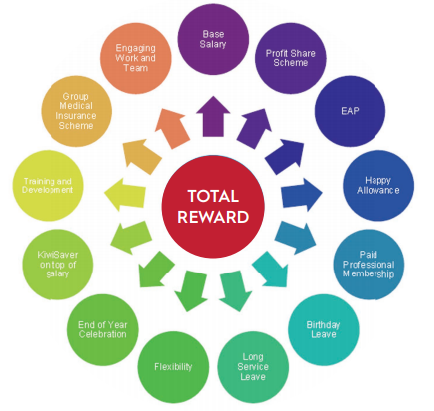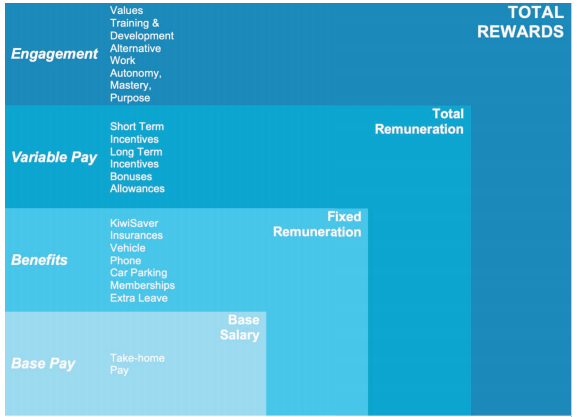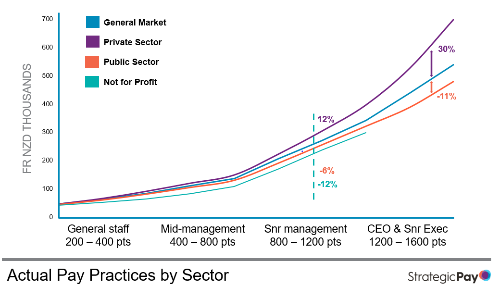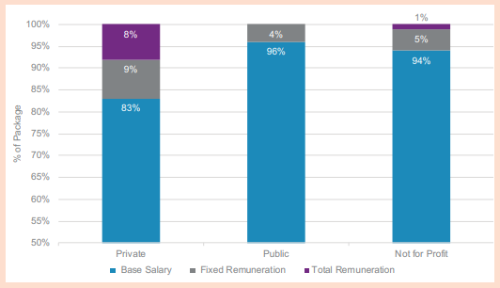This article was published on https://www.hcamag.com/nz
In this talent short market, organisations taking a total rewards approach to their pay will be able to stand out from the crowd. Total Rewards describes a reward strategy bringing together all the investments an organisation makes in its workforce, e.g. pay, insurances, learning & development, etc. It includes everything employees may value in working for an organisation, such as flexible working and career opportunities. It goes beyond base pay by highlighting the range of benefits within the employment package that underpins the organisation’s culture and organisational objectives. It promotes and encourages employee engagement, which in turn improves organisational performance. It aims to give all employees a “voice and choice” on the Total Rewards offerings and enhance the psychological contract between employer and employee.
Total Rewards communicates a range of monetary and non-monetary rewards as shown in the diagram below, which can assist organisations in promoting and enhancing their reputation as a great place to work.

The success of a Total Rewards approach relies upon, both the organisation clearly communicating what it is trying to achieve through the organisations’ objectives, and the ability of line managers to actively engage and motivate their teams. A Total Rewards approach is a tool that can assist with engaging the workforce; it will not in itself engage people unless managers know what engagement really means and more importantly apply it in their day-to-day activities.
Base Pay in the Foundation of Total Rewards
While Total Rewards as a philosophy emphasises all aspects of the employee proposition, base pay remains the foundation on which everything else is built. It continues to be a key consideration for employees joining an organisation. Highlighting other elements of the employment package does not mean employees will forget about their base pay, which needs to be fair and equitable. Once base pay is perceived to be fair by employees, communicating the value of the more intangible elements of the employment package can help to bring about higher levels of engagement, improve recruitment and retention, and – ultimately – increase productivity.
What do Employees Want?
Employees want to knw three things about their pay:
- Am I fairly rewarded in comparison with similar jobs within my organisation?
- Am I fairly rewarded in comparison with similar jobs in other organisations?
- Am I fairly rewarded in relation to my contribution and performance?
The answers to these questions lie in the maturity and equity of the remuneration framework and the level of transparency the organisation promotes.
If organisations want to motivate their workforce, they need to understand what their employees really value and tailor the remuneration strategies around this. The table below represents layers of rewards – cash, benefits, pay for performance, and unique offerings that enhance the overall employee experience. Base Salary, Fixed, and Total Remuneration are quantifiable and readily compared against the remuneration market. While offerings like flexible work may be less readily quantifiable but an important and valued aspect of Total Rewards.

What sector differences do we see in the New Zealand Market?
If we consider the current New Zealand practices, we see a wide range of benefits, variable pay, and engagement initiatives on offer across the sectors.
From a base pay perspective, it will come as no surprise that the Private Sector leads the way in terms of salary rates and the lowest paying sector is in the Not for Profit. As illustrated in the following graph.

What is interesting to note, is that the Private Sector also leads the way in terms of benefits on offer. When we look at the Strategic Pay March 2021 NZ Remuneration Survey, we see some large differences between the Public and Private Sectors. At the Senior Management level, for example, 10.6% of Public Sector organisations offer medical insurance while 27.8% offer medical insurance in the Private Sector. The same can be said for motor vehicles, 15.4% of Private Sector organisations offer a motor vehicle compared to 8.5% of Public Sector organisations. You can take this analysis one step further and consider the job functions within these sectors. IT roles in this survey show an incidence of 0.7% of motor vehicles at the senior management level, compared to 39.4% of Trades and Labouring roles. Interestingly this is reversed when we consider medical insurance. 15.2% of Trades and Labouring roles have medical insurance compared to 18.8% for IT roles.
Variable or at-risk pay is not at all common in the Public Sector, in the last 12 months to March 2021 only 4.2% of Senior Managers received incentive payments compared to 35.1% in the Private Sector. This difference in the package makeups is illustrated further in the following graph.
The following graph shows the composition of pay packages for Chief Executives, by sector:
In the Private Sector, benefits and variable pay make up a greater proportion of their total packages. This graph however doesn’t represent the other benefits or elements of a Total Reward package that the Public and Not for Profit Sector offer.
In the Not for Profit Sector, for instance, we typically see a greater sense of purpose and alignment to values. The Public Sector typically has better leave provisions and is more likely to offer a 37.5-hour working week than in the private sector.
Finally, with regards to training and development opportunities, we also see variations between the sectors. The following table is taken from the Strategic Pay 2020 HR Metrics Survey:

It is clear that the public sector actually spends more on training and development, from an employee perspective, if opportunities for training or growth is a key motivator to them, they may overlook a higher salary package in the Private Sector and be encouraged to take on a Public Sector role instead.
What is clear from the information presented above, is that when taking a Total Rewards approach to pay you need to consider how your organisation stacks up against the various elements as there is a lot of variability across sectors and industries. A well-considered and well-communicated Total Rewards approach however can help differentiate an organisation in the market.
Given this talent shortage is likely to remain in the New Zealand market for the medium to long term, such an approach could go a long way towards helping you stand out of the crowd. What will be crucial is ensuring you have the right information to hand to help you benchmark appropriately. Strategic Pay can offer a wider suite of survey information and detailed information on common policies and practices in the New Zealand Market. If you are considering adopting a Total Rewards approach, get in touch with one of our experts.
At Strategic Pay, our consultants are well equipped to support you with finding the best approach to attract, motivate and retain your staff. Our reports provide comprehensive details which enable you to make informed HR policy decisions for your organisation. We have a wide range of solutions to match your unique situation. Contact us today at info@strategicpay.co.nz or regional contact details can be found here.

